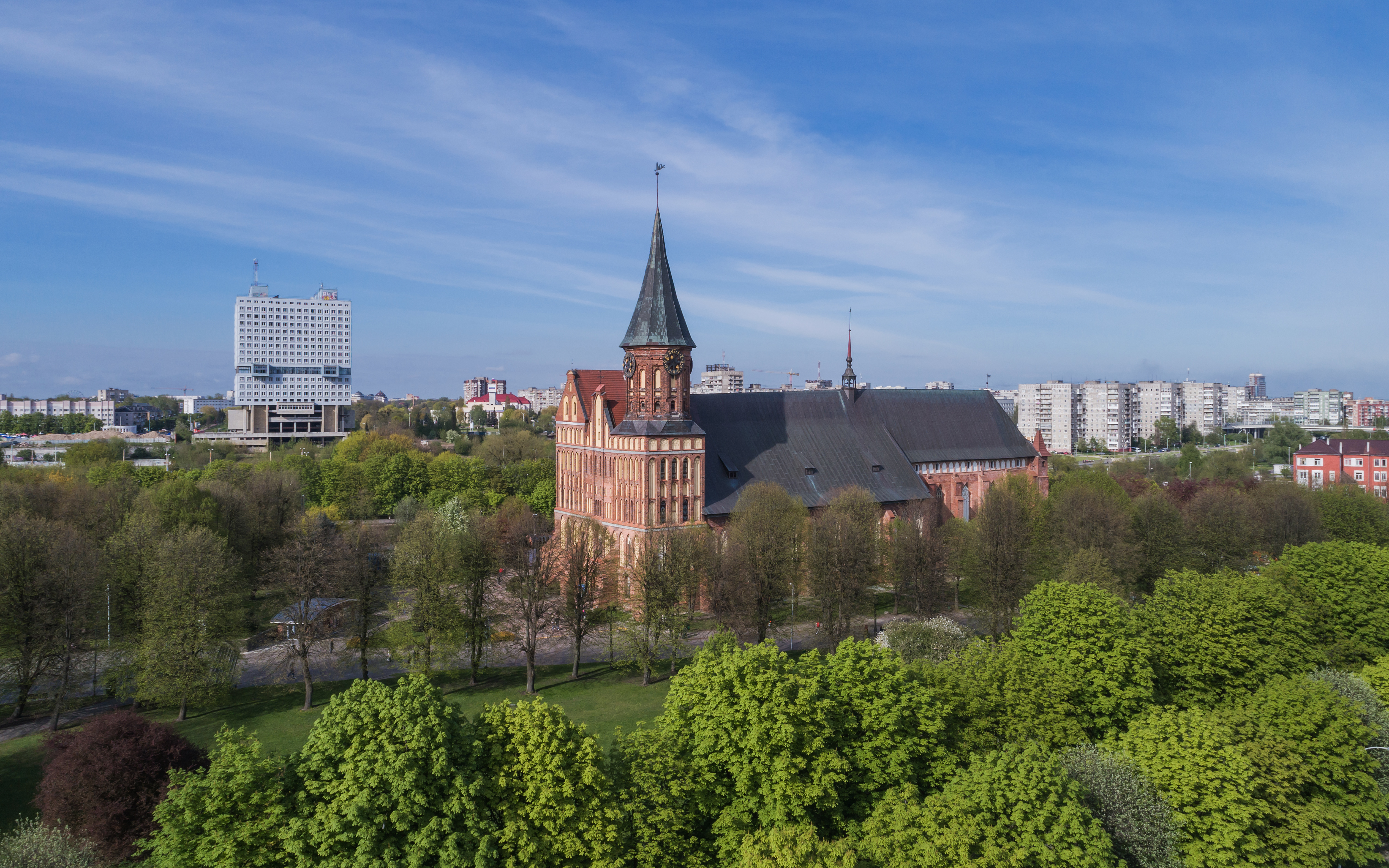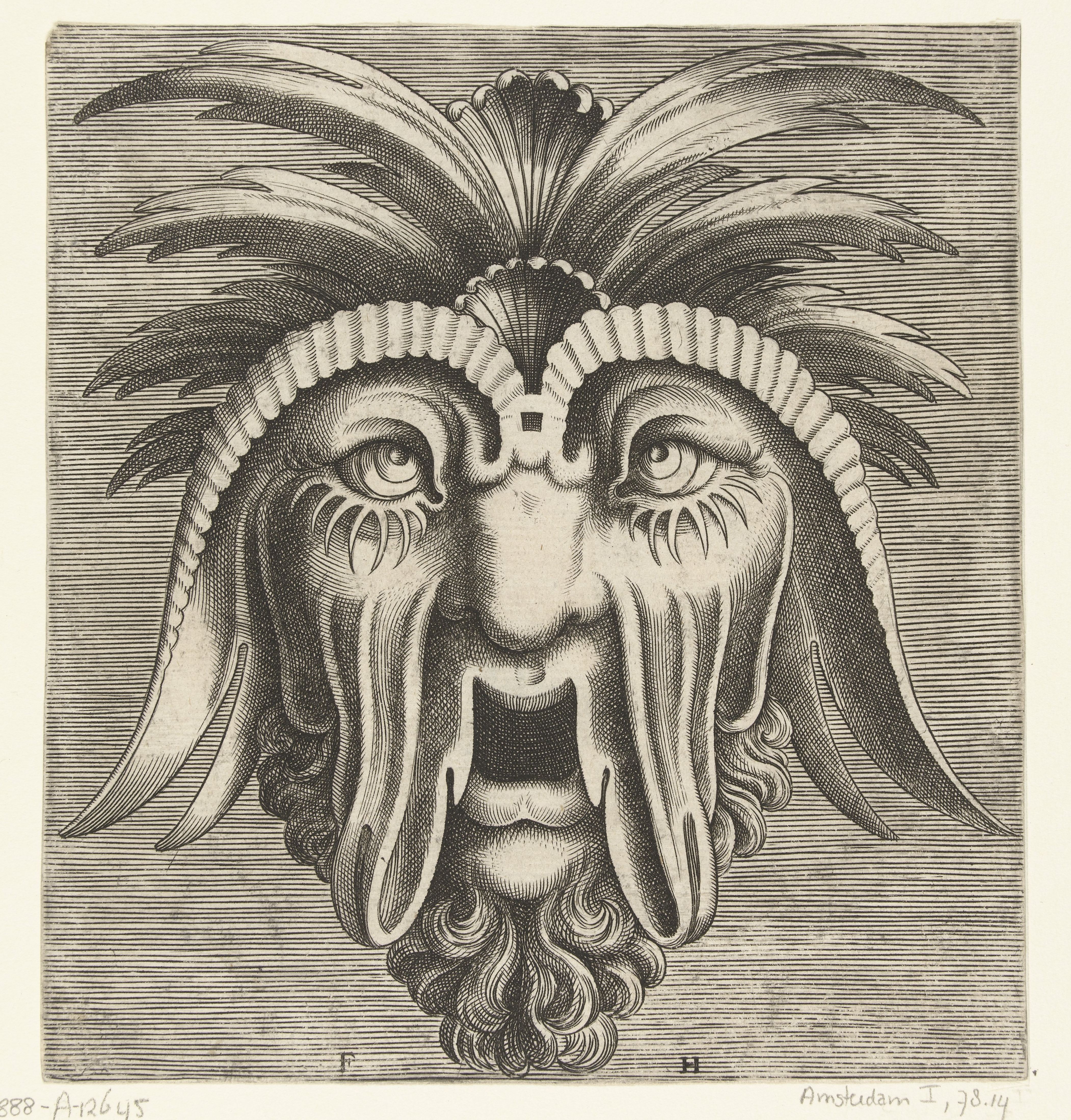|
Königsberg Cathedral
Königsberg Cathedral (; ) is a Brick Gothic-style monument in Kaliningrad, Russia, located on Kneiphof island in the Pregolya river. It is the most significant preserved building of the former city of Königsberg, which was largely destroyed in World War II. Dedicated to the Virgin Mary and St. Adalbert of Prague, it was built as the see of the Diocese of Samland, Prince-Bishops of Samland in the 14th century. Upon the establishment of the secular Duchy of Prussia, it became the Lutheran University of Königsberg, Albertina University church in 1544. The spire and roof of the cathedral burnt down after Bombing of Königsberg in World War II, two RAF bombing raids in late August 1944; reconstruction started in 1992, after the dissolution of the Soviet Union. History 14th century to World War II A first smaller Catholic Church, Catholic cathedral was erected in the Königsberg Altstadt (Königsberg), Altstadt between 1297 and 1302. After the Samland bishop Johann Clare had acquir ... [...More Info...] [...Related Items...] OR: [Wikipedia] [Google] [Baidu] |
Lutheranism
Lutheranism is a major branch of Protestantism that emerged under the work of Martin Luther, the 16th-century German friar and Protestant Reformers, reformer whose efforts to reform the theology and practices of the Catholic Church launched the Reformation in 1517. The Lutheran Churches adhere to the Bible and the Ecumenical Creeds, with Lutheran doctrine being explicated in the Book of Concord. Lutherans hold themselves to be in continuity with the apostolic church and affirm the writings of the Church Fathers and the first four ecumenical councils. The schism between Roman Catholicism and Lutheranism, which was formalized in the Diet of Worms, Edict of Worms of 1521, centered around two points: the proper source of s:Augsburg Confession#Article XXVIII: Of Ecclesiastical Power., authority in the church, often called the formal principle of the Reformation, and the doctrine of s:Augsburg Confession#Article IV: Of Justification., justification, the material principle of Luther ... [...More Info...] [...Related Items...] OR: [Wikipedia] [Google] [Baidu] |
University Of Königsberg
The University of Königsberg () was the university of Königsberg in Duchy of Prussia, which was a fief of Poland. It was founded in 1544 as the world's second Protestant Reformation, Protestant academy (after the University of Marburg) by Duke Albert, Duke of Prussia, Albert of Prussia and charted by the King Sigismund II Augustus. It was commonly known as the Albertina and served as a Protestant counterpart to the Catholic Jagiellonian University in Kraków. Following World War II, the city of Königsberg was transferred to the Soviet Union according to the 1945 Potsdam Agreement, and renamed Kaliningrad in 1946. The Albertina was closed and the remaining German population Flight and expulsion of Germans (1944–1950), expelled, by the terms of the Potsdam Agreement. Today, the Immanuel Kant Baltic Federal University in Kaliningrad claims to maintain the traditions of the Albertina. History Albert, former Grand Master of the Teutonic Order and first Duchy of Prussia, Duke of P ... [...More Info...] [...Related Items...] OR: [Wikipedia] [Google] [Baidu] |
Johann Briesmann
Johann, typically a male given name, is the German form of ''Iohannes'', which is the Latin form of the Greek name ''Iōánnēs'' (), itself derived from Hebrew name '' Yochanan'' () in turn from its extended form (), meaning "Yahweh is Gracious" or "Yahweh is Merciful". Its English language equivalent is John. It is uncommon as a surname. People People with the name Johann include: Mononym * Johann, Count of Cleves (died 1368), nobleman of the Holy Roman Empire *Johann, Count of Leiningen-Dagsburg-Falkenburg (1662–1698), German nobleman *Johann, Prince of Hohenzollern-Sigmaringen (1578–1638), German nobleman A–K * Johann Adam Hiller (1728–1804), German composer * Johann Adam Reincken (1643–1722), Dutch/German organist * Johann Adam Remele (died 1740), German court painter * Johann Adolf I, Duke of Saxe-Weissenfels (1649–1697) * Johann Adolph Hasse (1699-1783), German Composer * Johann Altfuldisch (1911—1947), German Nazi SS concentration camp officer executed fo ... [...More Info...] [...Related Items...] OR: [Wikipedia] [Google] [Baidu] |
Martin Von Wallenrodt
Martin may refer to: Places Antarctica * Martin Peninsula, Marie Byrd Land * Port Martin, Adelie Land * Point Martin, South Orkney Islands Europe * Martin, Croatia, a village * Martin, Slovakia, a city * Martín del Río, Aragón, Spain * Martín River, a tributary of the Ebro river in Spain * Martin (Val Poschiavo), Switzerland England * Martin, Hampshire * Martin, Kent * Martin, East Lindsey, Lincolnshire, a hamlet and former parish * Martin, North Kesteven, Lincolnshire, a village and parish * Martin Hussingtree, Worcestershire * Martin Mere, a lake in Lancashire ** WWT Martin Mere, a wetland nature reserve that includes the lake and surrounding areas North America Canada * Rural Municipality of Martin No. 122, Saskatchewan, Canada * Martin Islands, Nunavut, Canada United States * Martin, Florida * Martin, Georgia * Martin, Indiana * Martin, Kentucky * Martin, Louisiana * Martin, Michigan * Martin, Nebraska * Martin, North Dakota * Martin, Ohio * Martin, South Carolina ... [...More Info...] [...Related Items...] OR: [Wikipedia] [Google] [Baidu] |
Cornelis Floris De Vriendt
Cornelis Floris or Cornelis (II) Floris De Vriendt (c. 1514 – 20 October 1575) was a Southern Netherlands, Flemish sculptor, architect, draughtsman, medallist and designer of prints and luxury. He operated a large workshop in Antwerp from which he worked on many large construction projects in Flanders, Germany and Denmark.Cornelis Floris (II) at the Netherlands Institute for Art History He was one of the designers of the Antwerp City Hall. He developed a new style, which was informed by Flemish traditions, the 16th century Italian Renaissance and possibly the School of Fontainebleau. His innovations spread throughout Northern Europe where they had a major influence on the development of sculpture and architecture in the 16th and early 17th centuries. [...More Info...] [...Related Items...] OR: [Wikipedia] [Google] [Baidu] |
Albert, Duke Of Prussia
Albert of Prussia (; 17 May 149020 March 1568) was a German prince who was the 37th grand master of the Teutonic Knights and, after converting to Lutheranism, became the first ruler of the Duchy of Prussia, the secularized state that emerged from the former Monastic State of the Teutonic Knights. Albert was the first European ruler to establish Lutheranism, and thus Protestantism, as the official state religion of his lands. He proved instrumental in the political spread of Protestantism in its early stage, ruling the Prussian lands for nearly six decades (1510–1568). Albert was great-grandson of the converted pagan ruler Jogaila of Poland and Lithuania, vanquisher of the Teutonic Knights at the Battle of Grunwald. He was also a member of the Brandenburg-Ansbach branch of the House of Hohenzollern. He became grand master of the Teutonic Knights in their attempt to diplomatically win over the Polish-Lithuanian union. His skill in political administration and leadership ult ... [...More Info...] [...Related Items...] OR: [Wikipedia] [Google] [Baidu] |
Renaissance
The Renaissance ( , ) is a Periodization, period of history and a European cultural movement covering the 15th and 16th centuries. It marked the transition from the Middle Ages to modernity and was characterized by an effort to revive and surpass the ideas and achievements of classical antiquity. Associated with great social change in most fields and disciplines, including Renaissance art, art, Renaissance architecture, architecture, politics, Renaissance literature, literature, Renaissance exploration, exploration and Science in the Renaissance, science, the Renaissance was first centered in the Republic of Florence, then spread to the Italian Renaissance, rest of Italy and later throughout Europe. The term ''rinascita'' ("rebirth") first appeared in ''Lives of the Artists'' () by Giorgio Vasari, while the corresponding French word was adopted into English as the term for this period during the 1830s. The Renaissance's intellectual basis was founded in its version of Renaiss ... [...More Info...] [...Related Items...] OR: [Wikipedia] [Google] [Baidu] |
Gothic Art
Gothic art was a style of medieval art that developed in Northern France out of Romanesque art in the 12th century, led by the concurrent development of Gothic architecture. It spread to all of Western Europe, and much of Northern Europe, Northern, Southern Europe, Southern and Central Europe, never quite effacing more classical styles in Italy. In the late 14th century, the sophisticated court style of International Gothic developed, which continued to evolve until the late 15th century. In many areas, especially Germany, Late Gothic art continued well into the 16th century, before being subsumed into Renaissance art. Primary media in the Gothic period included sculpture, panel painting, stained glass, fresco and illuminated manuscripts. The easily recognisable shifts in architecture from Romanesque to Gothic, and Gothic to Renaissance styles, are typically used to define the periods in art in all media, although in many ways figurative art developed at a different pace. The ear ... [...More Info...] [...Related Items...] OR: [Wikipedia] [Google] [Baidu] |
Luther Von Braunschweig
Luther von Braunschweig (also known as Lothar of Brunswick; 18 April 1335) was a German nobleman who served as the 18th Grand Master of the Teutonic Order from 1331 to 1335. Life Luther was a younger son of the House of Welf, Welf duke Albert I, Duke of Brunswick-Lüneburg, Albert I of Brunswick-Lüneburg (1236–1279) and his second wife Adelaide (1242–1284/85), daughter of Margrave Boniface II, Marquess of Montferrat, Boniface II of Montferrat. His elder brothers Henry I, Duke of Brunswick-Grubenhagen, Henry, Albert II, Duke of Brunswick-Lüneburg, Albert II and William I, Duke of Brunswick-Lüneburg, William succeeded their father in the Brunswick principalities of Principality of Grubenhagen, Grubenhagen, Principality of Göttingen, Göttingen and Principality of Brunswick-Wolfenbüttel, Wolfenbüttel. He was first documented as a Teutonic Knight in 1295, serving in the Prussia (region), Prussian lands; from 1304 in the entourage of the ''Landmeister''. From 1308 to 1 ... [...More Info...] [...Related Items...] OR: [Wikipedia] [Google] [Baidu] |
State Of The Teutonic Order
The State of the Teutonic Order () was a theocratic state located along the southeastern shore of the Baltic Sea in northern Europe. It was formed by the knights of the Teutonic Order during the early 13th century Northern Crusades in the region of Prussia. In 1237, the Livonian Brothers of the Sword merged with the Teutonic Order of Prussia and became known as its branch – the Livonian Order (while their state, ''Terra Mariana'', covering present-day Estonia, Latvia, and a small part of Russia, became part of the State of the Teutonic Order). At its greatest territorial extent during the early 15th century, the State encompassed Chełmno Land, Courland, Gotland, Livonia, Estonia, Neumark, Pomerelia ( Gdańsk Pomerania), Prussia and Samogitia. Following the battles of Grunwald in 1410 and Wilkomierz in 1435, the State fell into decline. After losing extensive territories in the imposed Peace of Thorn in 1466, the extant territory of its Prussian branch became known as M ... [...More Info...] [...Related Items...] OR: [Wikipedia] [Google] [Baidu] |
Altstadt (Königsberg)
image:ID004013 B443 AltstaedtMarkt.jpg, Altstadt's marketplace image:Coat-of-Arms-of-Kaliningrad-of-Altstadt-(Koenigsberg).svg, Coat of arms of Altstadt Altstadt was a quarter (urban subdivision), quarter of central Königsberg, Prussia. During the Middle Ages it was the most powerful of the three towns that composed the city of Königsberg, the others being Löbenicht and Kneiphof. Its territory is now part of Kaliningrad, Russia. History Foundation Construction of Königsberg Castle began in 1255 during the conquest of Sambia Peninsula, Samland by the Teutonic Knights, part of the Prussian Crusade. An initial settlement was founded north of the castle (later known as Steindamm (Königsberg), Steindamm) the following year, but this was destroyed by Sambians during the 1262 Siege of Königsberg.Albinus, p. 20 A new fortified settlement developed south of the castle between it and the Pregolya, Pregel River in 1264. Landmeister Konrad von Thierberg granted the settlement Kulm right ... [...More Info...] [...Related Items...] OR: [Wikipedia] [Google] [Baidu] |






